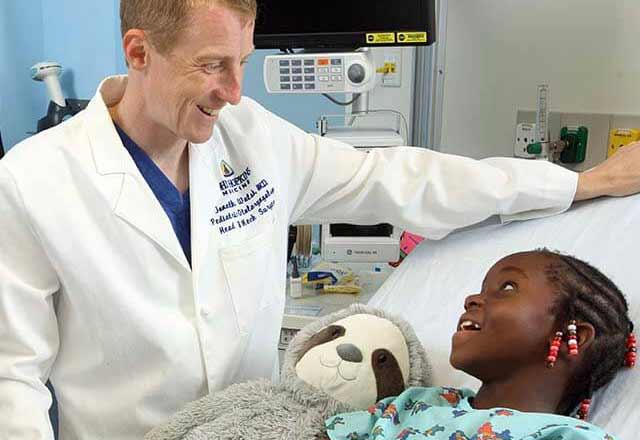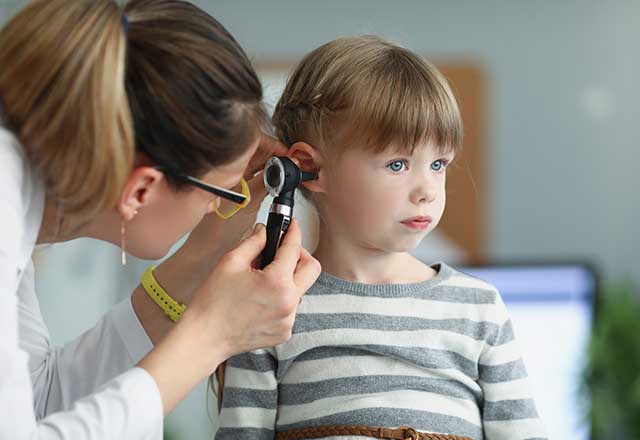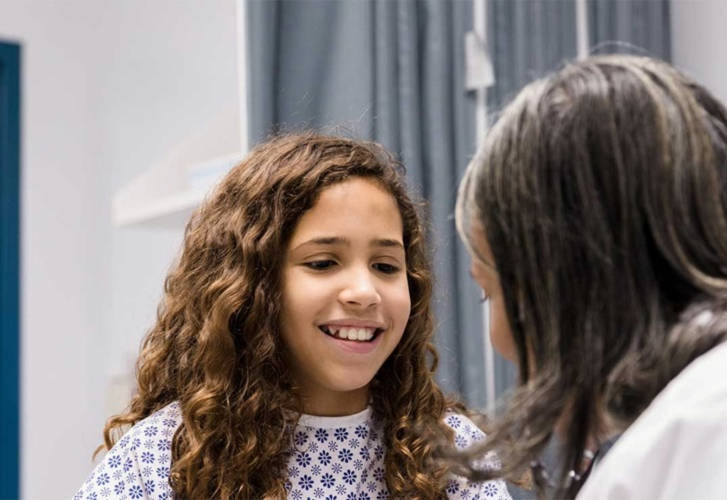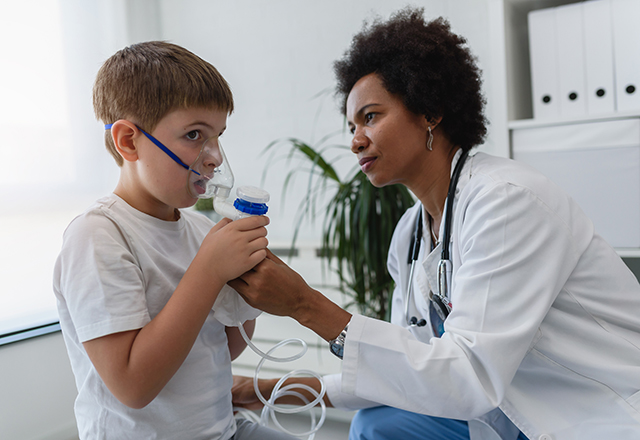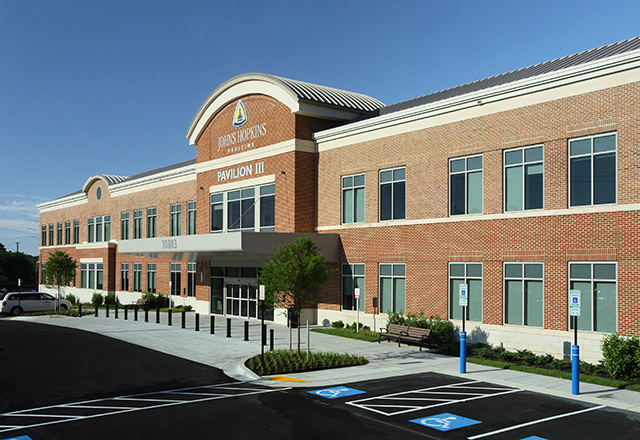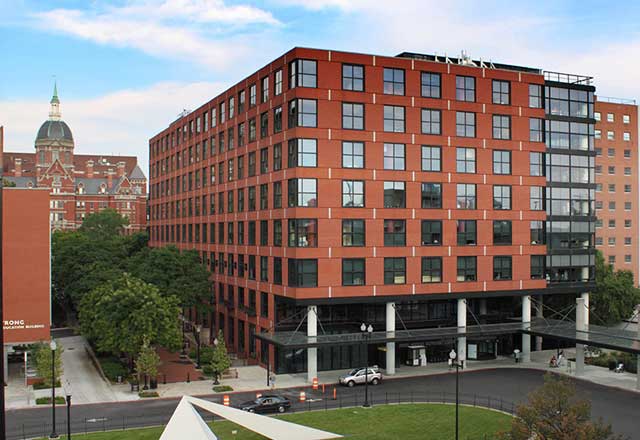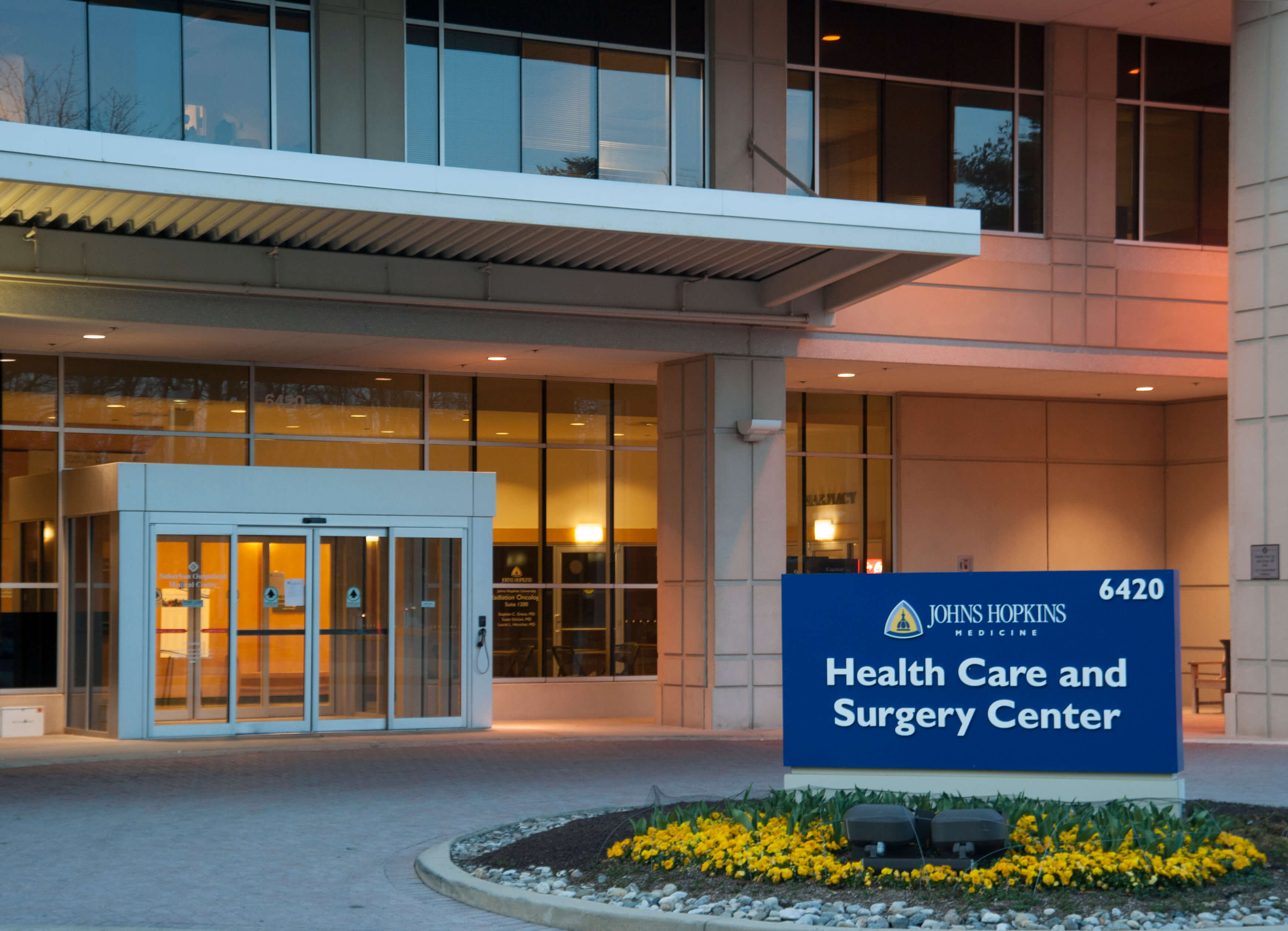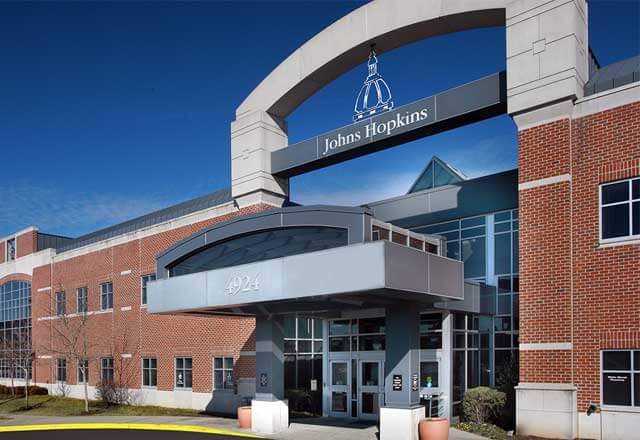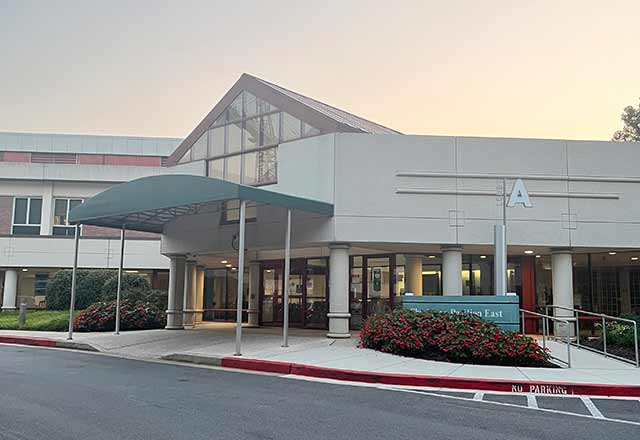Ear, nose and throat conditions affect children of all ages. Our pediatric otolaryngologists, also known as ear, nose and throat specialists (ENTs), use advanced techniques to treat both common and rare conditions. As part of the Johns Hopkins Children's Center, you have access to all the specialized resources of a children's hospital. Our teams are committed to providing your child with the highest level of care, in a warm, friendly and supportive environment.
Schedule an Appointment
Schedule by phone
Schedule online through MyChart
Conditions We Treat
-
The aerodigestive clinic specializes in treating children with complex conditions that affect both respiratory and digestive systems. These conditions may cause chronic cough, persistent bronchitis or other symptoms that can be difficult to diagnose.
Our clinic can help with respiratory and digestive problems related to:
- Chronic Upper and lower airway infections
- Birth defects, such as tracheobronchomalacia or tracheal stenosis
- Laryngotracheosophageal cleft
- Other anatomical abnormalities
Our team includes a gastroenterologist, otolaryngologist, pulmonologist, and speech-language pathologist, who work together to provide comprehensive care for patients with aerodigestive problems. Patients can see all specialists in one visit, which helps us streamline and coordinate diagnosis and treatment, avoiding unnecessary delays.
To request an appointment, please call 443-997-6467
-
Learn more about different ear conditions.
- Ear infection, acute otitis media
- Otitis externa (swimmer’s ear)
- Middle ear fluid, chronic otitis media, otitis media with effusion
- Tympanostomy tubes
- Cholesteatoma
- Hearing loss
- Ruptured eardrum (tympanic membrane perforation)
- Eustachian tube dysfunction
- Failed newborn and/or hearing screens
- Ear drainage
- Foreign body in the ear
- Ear pits, cysts or tags, hole in ear (preauricular pits)
- Microtia/aural atresia or abnormality of ear pinna or canal
- Vestibular Disorders
What to Expect at Your Appointment
Our pediatric ENT doctors will have a thorough discussion of your child’s medical history and will perform a comprehensive examination of the ears, nose and throat, head and neck. We use an otoscope to examine the ear canal and ear drum.
When needed, a more detailed exam may be performed, or if there is material or foreign body in the ear canal that prevents examination of the ear drum. Cultures and special medical treatment may also be done with the microscope. In this case, we use a microscope to remove the material and examine the ear drum.
A hearing test may be requested to make sure your child isn’t experiencing hearing loss. This can be done in our clinic with a pediatric audiologist. Our treatment of hearing loss is centered around the type and degree of hearing loss identified in the hearing test, that is why hearing aids may be recommended for children with hearing loss that cannot be otherwise corrected.
When diagnostic testing such as a CT scan or MRI is needed, this can be done in our pediatric radiology department with a team that includes experts from child life, pediatric radiology and pediatric anesthesia. We review diagnostic tests in our monthly multidisciplinary radiology rounds.
Depending upon the condition, treatment may include medication or surgery.
Surgery may include:- Tympanostomy tubes
- Tympanoplasty
- Myringoplasty
- Mastoidectomy
- Removal of cholesteatoma
- Removal of ear pits, cysts or tags
- Removal of tympanostomy tubes
- Removal of ear foreign body
- Bone anchored hearing aid
- Cochlear implant surgery
When indicated we refer to other pediatric specialists who are part of our team, such as geneticists, audiologists, speech language pathologists and plastic surgeons to help with diagnosis as well as coordinate surgery.
For young infants who fail newborn screening, we have a clinic that will see them within one to two months. The iHeardd Clinic can evaluate your infant and perform more advanced diagnostic testing, including ABR hearing tests to find out if there is hearing loss. If hearing loss is confirmed, further evaluation and testing may be suggested.
-
Learn more about different nasal conditions.
- Nasal turbinate hypertrophy
- Snoring in children
- Adenoiditis, enlarged adenoids
- Nasal mass
- Nasal obstruction
- Nosebleed
- Sinusitis
- Nasal dermoid
- Nasal polyps
- Antrochoanal polyps
- Rhinitis
- Nasal fracture
- Septal deviation
- Congenital nasal deformities
- Choanal atresia
- Pyriform aperture stenosis
- Anosmia or smell disorders
- Foreign body in nose
- Sleep apnea
What to Expect at Your Appointment
Our pediatric ENT doctors will have a thorough discussion with you about your child’s medical history and will perform a comprehensive examination of the ears, nose and throat, head and neck. We will use lighted instruments to examine the nasal cavity.
Sometimes a more detailed exam of the nose, throat, or voice box is needed. In this case, we use a lighted scope to examine the nasal cavity and adenoids. Cultures can be taken to identify the type of infections. We can evaluate for loss of smell with a smell test. Cautery of nasal septum can be done in the clinic with some children with nosebleeds. We can remove nasal foreign bodies in clinic.
If diagnostic tests such as a CT scan or MRI are needed, this can be done in our pediatric radiology department with our team, including experts from child life, pediatric radiology and pediatric anesthesia. We review some diagnostic tests in our monthly multidisciplinary radiology rounds. If a sleep study is needed for children who snore or have problems sleeping, this can be done at our Pediatric Sleep Center.
Depending upon the condition, treatment may include medication or surgery.
Surgery may include:- Adenoidectomy
- Tonsillectomy
- Removal of nasal polyps
- Removal of nasal dermoid
- Reduction of nasal fracture
- Reduction of nasal turbinates
- Septoplasty
- Repair of choanal atresia and pyriform aperture stenosis
- Cautery of nasal septum
- Removal of nasal mass
- Sinus surgery, including minimally invasive sinus surgery using balloon dilation
Sometimes we refer to other pediatric specialists who are part of our team, such as pulmonologists, allergists, geneticists and plastic surgeons to help with diagnosis as well as coordinate surgery.
-
Learn more about different mouth and throat conditions.
- Sleep apnea
- Sore throat and tonsillitis
- Dysphagia, swallowing problems
- Oral cavity lesions or masses
- Velopharyngeal insufficiency
- Tongue tie
- Ranula
- Mucocele
- Cleft palate
- Bifid uvula
Our pediatric ENT doctors will have a thorough discussion with you about your child’s medical history and will perform a comprehensive examination of the ears, nose and throat, head and neck, and chest. Please bring available videos or material related to any snoring or speech concerns you may have.
Sometimes a more detailed exam of the palate, larynx or voice box is needed. In this case, we use a lighted scope to examine the nasal cavity and adenoids, larynx and vocal cords; this is called fiberoptic laryngoscopy. This can be done in the clinic. We can release tongue tie in clinic in infants. If the lower airways need to be evaluated, we will perform laryngoscopy and bronchoscopy, which can be done in the operating room on another visit.
If diagnostic tests such as a CT scan or MRI are needed, this can be done in our pediatric radiology department with our team, including specialists from child life, pediatric radiology and pediatric anesthesia. We review some diagnostic tests in our monthly multidisciplinary radiology rounds. If a sleep study is needed, this can be done at our Pediatric Sleep Center.
Depending upon the condition, treatment may include medication or surgery.
Surgery may include:
- Bronchoscopy
- Removal of oral or throat masses or lesions
- Pharyngeal flap or palatoplasty
- Frenulotomy
- Injection and repair of laryngeal cleft
- Tonsillectomy and adenoidectomy
Sometimes we refer to other pediatric specialists who are part of our team, such as pulmonologists, allergists, geneticists, dentists, orthodontists, speech language pathologists and plastic surgeons to help with diagnosis as well as coordinate surgery. We have a cleft palate and craniofacial team and an aerodigestive multidisciplinary clinic for patients with complex swallowing and feeding problems.
-
Learn more about different airway conditions.
- Foreign body
- Laryngomalacia
- Stridor, wheezing or noisy breathing
- Vocal cord paralysis
- Vocal cord lesions
- Vocal cord dysfunction
- Recurrent respiratory papillomatosis
- Laryngeal tracheal stenosis
- Laryngeal cleft
- Vascular anomalies
- Hoarseness
- Dysphagia
- Tracheostomy
- Tracheomalacia
- Chronic cough
- Vallecular cyst
- Sleep apnea
What to Expect at Your Appointment
Our pediatric ENT doctors will have a thorough discussion with you about your child’s medical history and will perform a comprehensive examination of the ears, nose and throat, head and neck, and chest. We would be glad to listen to any videos or audio file on your phone of your child’s breathing or voice.
Sometimes a more detailed exam of the larynx or voice box is needed. In this case, we use a lighted scope to examine the nasal cavity and adenoids, larynx and vocal cords; this is called fiberoptic laryngoscopy. This can be done in the clinic. If the lower airways need to be evaluated, our doctors will perform laryngoscopy or bronchoscopy, which can be done with general anesthesia in the operating room on another visit.
If diagnostic tests such as a CT scan or MRI are needed, this can be done in our pediatric radiology department with our team, including specialists from child life, pediatric radiology and pediatric anesthesia. We review some diagnostic tests in our monthly multidisciplinary radiology rounds. If a sleep study is needed for children who snore or have sleeping problems, this can be done at our Pediatric Sleep Center.
Depending upon the condition, treatment may include medication or surgery.
Surgery may include:- Bronchoscopy
- Supraglottoplasty or surgery for laryngomalacia
- Removal of vocal cord lesions
- Tracheostomy
- Airway dilatation and reconstruction
- Injection and repair of laryngeal cleft
- Tonsillectomy and adenoidectomy
Sometimes we refer to other pediatric specialists who are part of our team, such as pulmonologists, allergists, speech language pathologists, geneticists and plastic surgeons to help with diagnosis as well as coordinate surgery.
-
Learn more about different head and neck conditions.
- Hemangioma and vascular malformations
- Head and neck masses
- Recurrent parotitis
- Facial paralysis
- Thyroid masses
- Lymphatic malformation
- Branchial cleft cyst or sinuses
- Thyroglossal duct cysts
- Skin lesions and lesions of the soft tissue (pilomatrixoma)
- Enlarged lymph node
- Nontuberculous mycobaterial infection of neck
What to Expect at Your Appointment
Our pediatric ENT doctors will have a thorough discussion with you about your child’s medical history and perform a comprehensive examination of the ears, nose and throat, head and neck, and chest.
Sometimes a more detailed exam of the larynx or voice box is needed. In this case, we use a lighted scope to examine the nasal cavity and adenoids, larynx and vocal cords; this is called fiberoptic laryngoscopy. We have an ultrasound machine in clinic that can be used if needed.
If diagnostic tests such as CT scan, ultrasound or MRIs are needed, this can be done in our pediatric radiology department with our team, including specialists from child life, pediatric radiology and pediatric anesthesia. We review some diagnostic tests in our monthly multidisciplinary radiology rounds. If a sleep study is needed for children who snore or have sleep problems, this can be done at our Pediatric Sleep Center.
Depending upon the condition, treatment may include medication or surgery.
Surgery may include:- Removal of neck mass, sinus or cyst
- Bronchoscopy
- Tracheostomy
- Airway dilatation and reconstruction
- Injection and repair of laryngeal cleft
- Tonsillectomy and adenoidectomy
Sometimes we refer to other pediatric specialists who are part of our team, such as pulmonologists, dermatologists, infectious disease specialists, facial plastic surgeons, geneticists and plastic surgeons to help with diagnosis as well as coordinate surgery. We have a vascular malformations team that specializes in the treatment of venous and lymphatic malformations.







